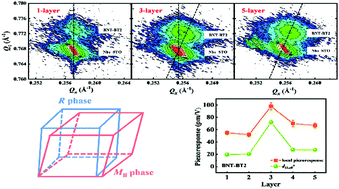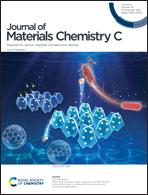Enhancement of piezoelectricity in spin-coated Bi1/2Na1/2TiO3-BaTiO3 epitaxial films by strain engineering
Abstract
Ferroelectric films can sustain large strain induced by substrate constraints, which may additionally modulate their crystal structures and electrical properties. This study revealed the strain engineering effect on the piezoelectricity of (100-x)%Bi1/2Na1/2TiO3-x%BaTiO3 (BNT-BTx) epitaxial films grown on Nb:SrTiO3100 (NSTO100) substrates in association with the crystal structure affected by film thickness. Several compositions in the BNT-BTx system, i.e. BNT-BT2, BNT-BT6 and BNT-BT15, were studied as typical representatives of ferroelectric rhombohedral, relaxor ferroelectric pseudo-cubic (near morphotropic phase boundary) and ferroelectric tetragonal structures, respectively. It was found that a monoclinic–rhombohedral phase transition appeared in BNT-BT2 films when we changed the film thickness, which was caused by the coherent strain imposed by the substrates. The 3-layer BNT-BT2 film (∼150 nm) exhibited a phase coexistence of monoclinic and rhombohedral phases, so that the effective piezoelectric constant  was enhanced by at least 260% compared to films with pure monoclinic or rhombohedral phases. The present work may offer a feasible way to improve the piezoelectric properties of other perovskite piezoelectric films.
was enhanced by at least 260% compared to films with pure monoclinic or rhombohedral phases. The present work may offer a feasible way to improve the piezoelectric properties of other perovskite piezoelectric films.



 Please wait while we load your content...
Please wait while we load your content...